Do you have trouble keeping your cat from darting out the door of your home? Perhaps your cat zips towards the door every time you're trying to enter or leave the house, leaving you with a racing heart and worry lines on your face.
If this scenario sounds all too familiar, you're not alone!
This nerve-wracking habit is more common than you might think, and as pet parents, it's our responsibility to ensure our fur-babies are safe.
In this article, we're taking a deep dive into the perplexing behavior of door-darting cats.
We'll start by exploring why our feline companions develop this risky tendency, what they find so alluring about the unknown world beyond the door, and how you can subtly decrease this curiosity.
We'll also look into tried-and-true strategies suggested by our very own TheCatSite community members.
So, whether you're dealing with a seasoned door-darter or trying to prevent your curious kitten from picking up this dangerous habit, this comprehensive guide is just what you need.
Let's unravel the mystery together and make every cat's indoor life safer and more exciting!
Why does my cat try to dash out the door?
Many cat owners report that their cats are very curious about the door leading out to the great outdoors or even just to the hall.
In fact, cats seem to have a passion for doors in general and our ability as humans to open these gates for them. Many cats are bothered when you keep a door closed inside the home and will constantly ask you to open it.
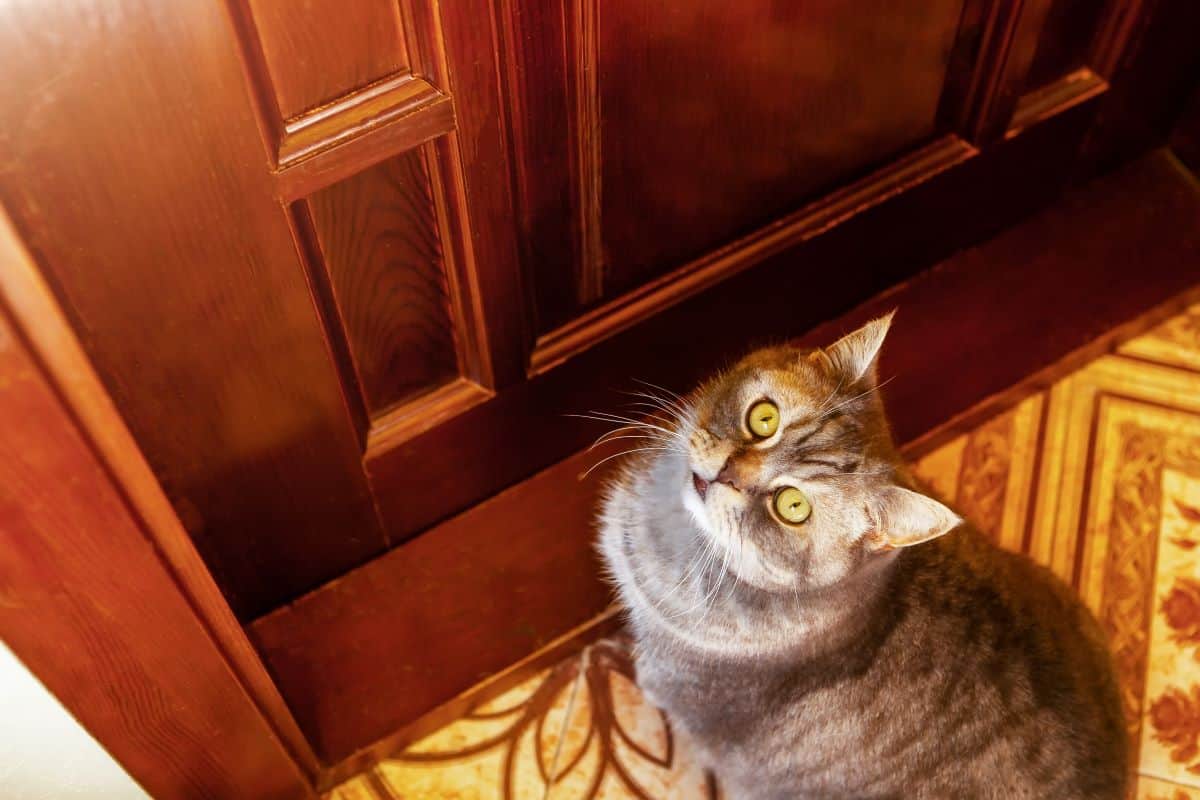
The reason is simple. Cats are territorial creatures. This is their home as much as it is yours, and they have a constant need to routinely patrol their territory. Those pesky doors literally get in their way so it's little wonder they're upset over them.
In many ways, our cats see us as the mother cat. When we go outside through the main door, Kitty is naturally curious and wants to explore further.
The same can sometimes happen in homes where there's a dog. The cat naturally wants to follow his canine sibling on those daily walks.
The smaller the home and the fewer the stimuli inside it, the more likely the cat is to want to explore outside.
Keep in mind that non-neutered males have an instinctive need for a very large territory. Keeping a non-neutered male cat indoors is complicated and likely leads to urine spraying.
That tomcat is also likely to try very hard to get outside. It's just another good reason to fix your cat.
Read more: Why You Should Spay And Neuter Your Cats
And then there's just feline personality. Some cats are born explorers and more curious than average. It may seem like they will stop at nothing in their quest to investigate the world.
Why you should keep your cat from darting outside
Some owners choose to allow their cats to get outside. Hopefully, that's to a sheltered enclosure, a fenced-in backyard, or any other setting where Kitty is protected from danger.
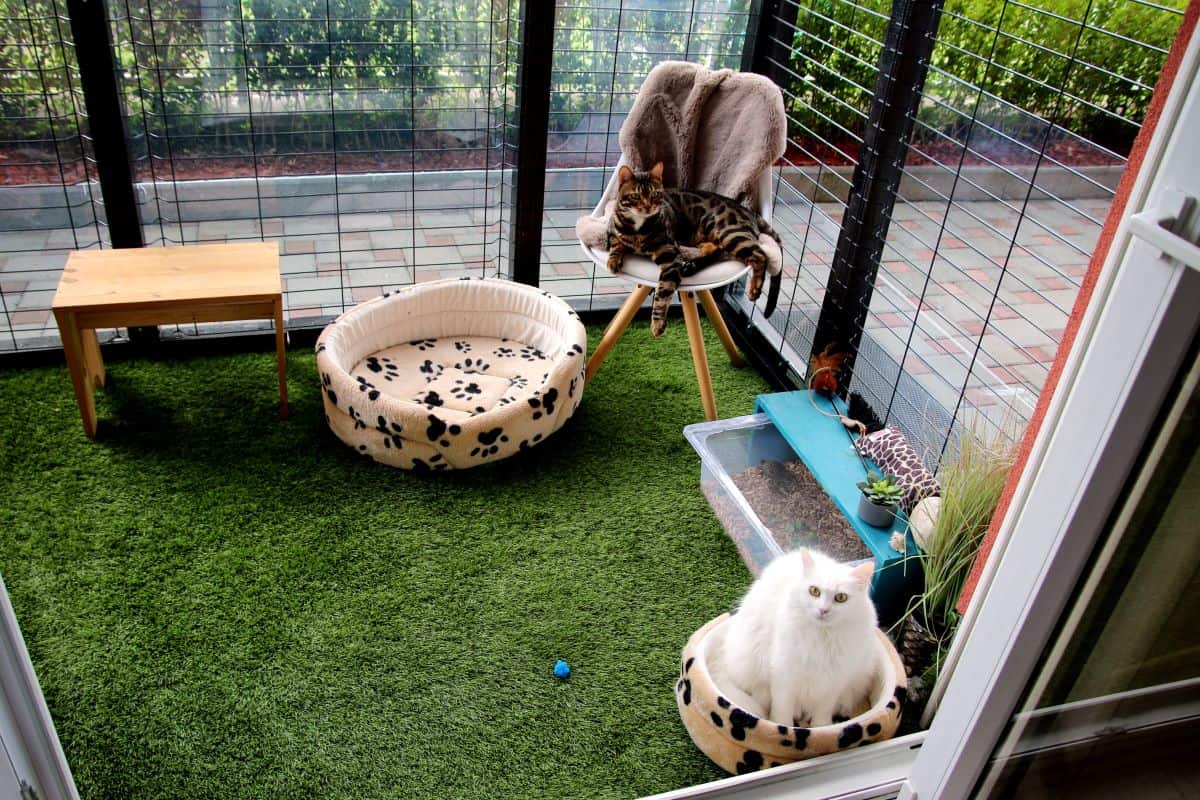
When that's the case, the cat usually has a cat flap or cat door through which he can come and go at will.
More and more owners choose to keep their cats indoors only. The advantages are clear and include protecting the cat from -
- Predators
- Dogs
- Malicious humans
- Traffic accidents
- Parasites and disease
Unfortunately, your cat may not understand why staying indoors is so important. He may keep trying to get outside by darting for the door as soon as it opens.
That can be very dangerous.
A cat who's not used to being outside is at greater risk of being hurt. That cat doesn't even know where to run to if a dog comes after him or if he meets a hostile neighborhood feral cat. Frightened and confused, he can easily run right into traffic.
Clearly, you do need to prevent your indoor-only cat from darting through the door. So, let's talk about how to achieve just that.
We'll start with how to train a cat to keep from darting out the door when it opens but do keep reading beyond that, too. The part that follows - how to adjust your cat's environment to lessen the need to explore outside - is equally important.
How to train your cat not to run out the door
Ideally, you should train your cat to remain calm and inside when the door opens. Training is better than just preventing escape using physical obstacles (which we'll cover in a bit) because it means Kitty stays inside even if someone accidentally removes all obstacles.
It's always better to start training as early as possible. Door darters are often mischievous kittens, and correcting the behavior is easier the younger they are.
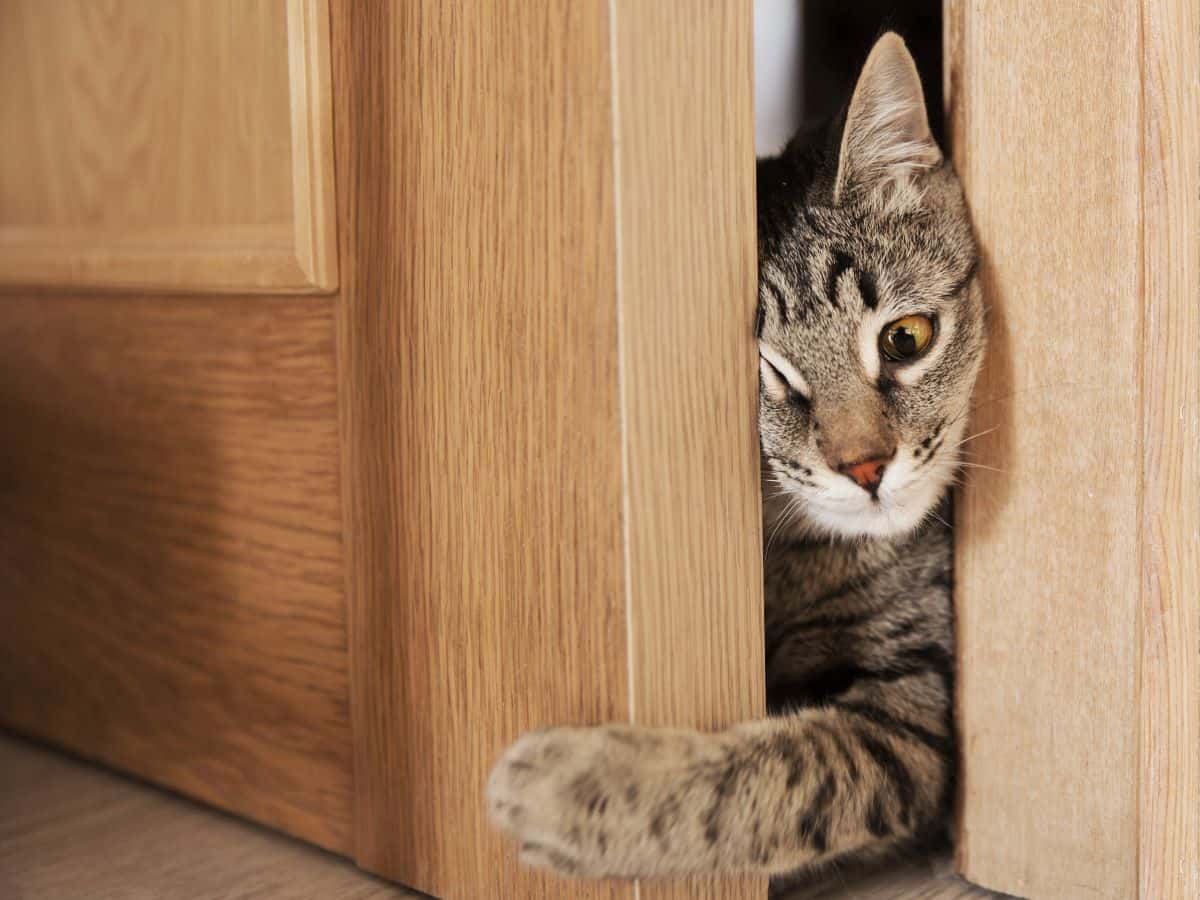
Here are the two main methods for training a cat to stay away from the door as you open it. The first uses positive reinforcement. The second uses scare tactics.
Always prefer the former, but if positive reinforcement doesn't work, consider teaching your cat to fear the door - it could literally save his life someday, so it's worth the price.
Positive training for teaching Kitty not to dart for the door
If you are the main person using the doorway and the cat's escape attempts are focused on your entry and exit, you could try the following method.
Avoid showing any kind of affection to your cat anywhere near the door. Keep quiet and don't even make eye contact.
Create an imaginary perimeter of several feet around the door where Kitty gets zero attention. You aim at teaching the cat that nothing positive comes from hanging around the door.
Establish a routine for your entry, where something positive happens away from the door. This should be like a ceremony that your cat will be familiar with.
As you enter, you ignore the cat near the door, move farther into the room to a specific location and greet Kitty there.
A good spot would be near a cat tree or Kitty's favorite scratching post. In fact, your cat may indeed feel the urge to scratch as you meet, so placing a scratching post there is a good idea.
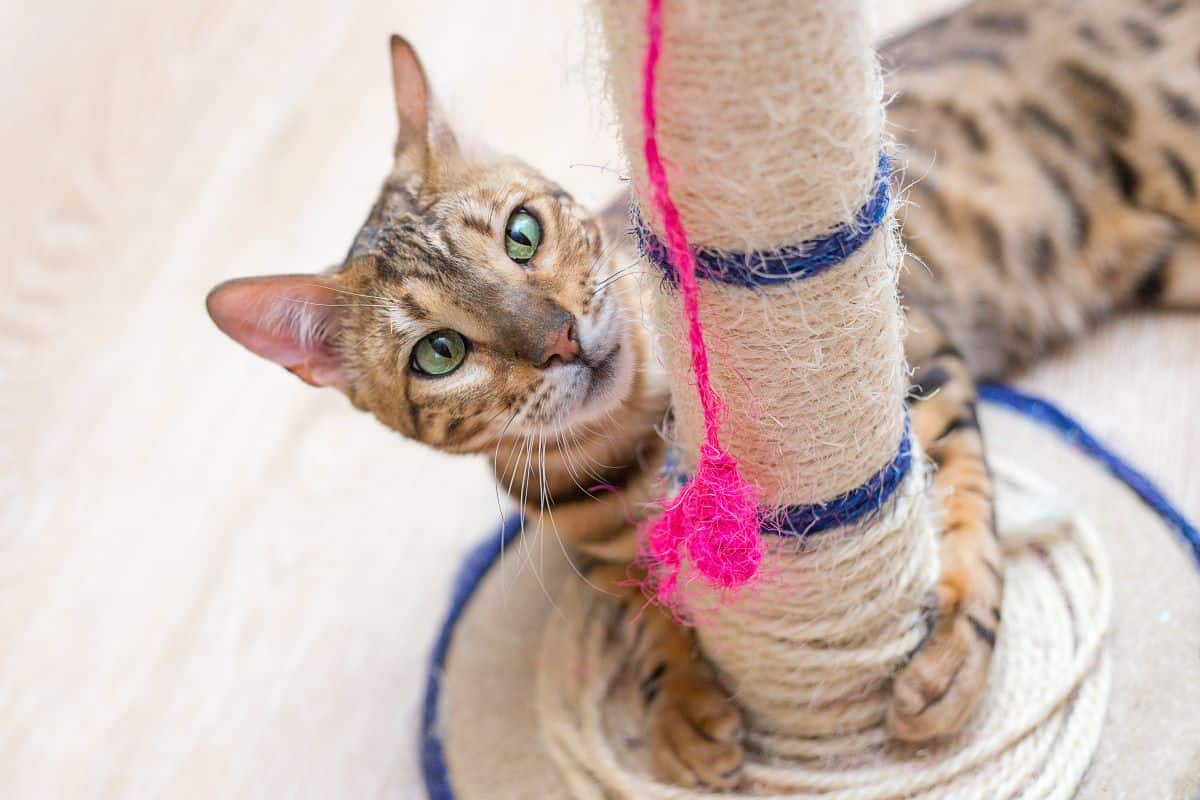
Once you reach the spot, you talk to your cat, pet him and shower him with love and attention.
At least during the first weeks, offer treats until the routine is firmly established. Either keep them in your pocket as you return home or keep them near the designated "meet and greet" point.
When leaving, place a few treats there and quickly leave as Kitty is busy munching on the treats. Try automated cat toys or treat balls if possible.
If your cat appreciates playing with laser toys, you could try directing his attention to the far corner of the room with that. Anything that will keep your cat happily engaged away from the door.
Try this for several weeks. It's the ideal way to teach your cat being near the door doesn't pay off. If your cat is still too intrigued by the door - or if you're not the only person routinely using the door, try the following method in addition to positive reinforcement.
Teach your cat to be scared of the door
As a rule, making your cat fear things is not a good idea. This is because some cats are naturally nervous and shy, and you don't want to add to their stress levels.
Too much stress might trigger health problems such as cystitis in some cats.
However, door darters are usually confident cats. When they try to run out, their confidence puts them in harm's way. In this case, making your cat associate the door with danger may be justified.
So how to go about it?
Start by using a loud noise when the cat is near the door. Preferably, have someone else wait outside as you open the door just a crack.
When Kitty comes running to the door, have that person make a loud scary noise right outside the door.
TheCatSite members have suggested these -
- Dropping a set of keys or even a can full of coins
- Using canned air spray (not aimed directly at the cat)
- Stomping on the floor
- Hissing at the cat
The idea is to create a loud noise that will scare the cat away. It's important that the cat does not associate you with the source of the noise, which is why it's best to get help from someone else.
Some experts suggest spraying water from the other side of the door to keep the cat from darting out the door.
While spraying water is generally not a good way to train cats - if all else fails you could try that too. Make sure not to spray the cat's face directly and again, have someone else do the spraying.
Try to physically block the door
If you find that you can't train your cat - or until the point when he is fully trained to avoid the door - you should try to physically block the door.
Many owners of door-darting cats report that they've learned to place a large object near the bottom of the door before they open it.
This could be grocery bags or a magazine - anything that will prevent a cat from darting through the door between the owner's legs.
Some people have a two-door setup which can be very helpful. Essentially, they have an additional door inside the hall. If the cat manages to run into the hall, he'll encounter the actual main door. The owner can then scoop Kitty up and get him safely inside.
SIGN UP FOR THECATSITE'S EMAIL UPDATES >
How to make your cat happy to stay inside
Now that we've talked about training your cat to avoid the door, it's also worth discussing how to create a home environment that reduces the need for exploration.
Essentially, you need to think about two things -
- Increasing your cat's territory.
- Making that territory more stimulating.
The first item may sound strange. After all, how can you make your home larger? The good news is that you can do that without building additional rooms.

Your cat would enjoy making better use of the vertical space in your home. That means adding cat furniture and cat shelves.
You can also add a cat enclosure. It can be as small as an enclosed area near a window or just a window perch.
If you have access to a backyard, you can create wonderful enclosures that will satisfy any cat's passion for the great outdoors - while keeping him safe.
Read more about creating an enclosure for your cat.
You should also make life more interesting for Kitty in general. That means adding more cat toys and scheduling interactive playtime.
The more interest you can inject into your cat's life, the less appealing the door will become.
Find more ideas here -
7 Proven Ways To Get Your Cat To Be More Active
Let's recap - How to Keep Your Cat From Darting Out The Door
You can do several things to prevent your cat from darting out the door, given the chance. Here are a few of the ideas we'll discuss in-depth in this article:
- Training the cat to stay inside when the door opens
- Teaching the cat to fear the door
- Providing extra mental and physical stimulation to lessen the need for outdoor exploration
- Setting up the area to prevent actual escape
And just in case...
If your cat has ever tried to escape, you should stay on the safe side and make sure your cat stands the best possible chance to get back home if he ever runs out again.
First, have Kitty microchipped and register the microchip. That way, if he ever gets lost and ends up in a shelter, he'll stand a good chance of being reunited with you.
Secondly, have your cat wear a safe cat collar with a clear tag with your phone number. If a well-meaning neighbor finds him, they can call you and get him back home.
Not everyone knows to take a cat to the vet to be scanned for a chip, so this is important too.
Also, if your cat is an escape artist who has learned how to open the door - yes, some cats do that! - make sure you catproof your doors with a deadbolt or sliding lock barrel bolt.
Read more on How to save your cat's life with proper identification
And if you have more tips and ideas on how to deal with cats who keep running to the door, please leave a comment and let us know!
SIGN UP FOR THECATSITE'S EMAIL UPDATES >




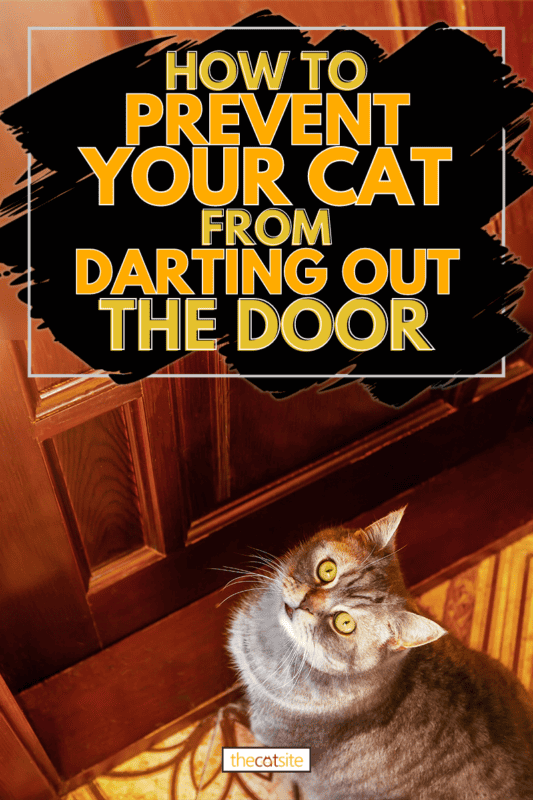
Note: We may get commissions for purchases made through links on this page.

![A gray Chartreux cat sticking out his tongue while looking at the camera, Cat Sticking Their Tongue Out? [Here's Why]](https://thecatsite.com/c/wp-content/uploads/2021/05/A-gray-Chartreux-cat-sticking-out-his-tongue-while-looking-at-the-camera-260x170.jpg)


27 comments on “4 Foolproof Ways To Prevent Your Cat From Darting Out The Door”